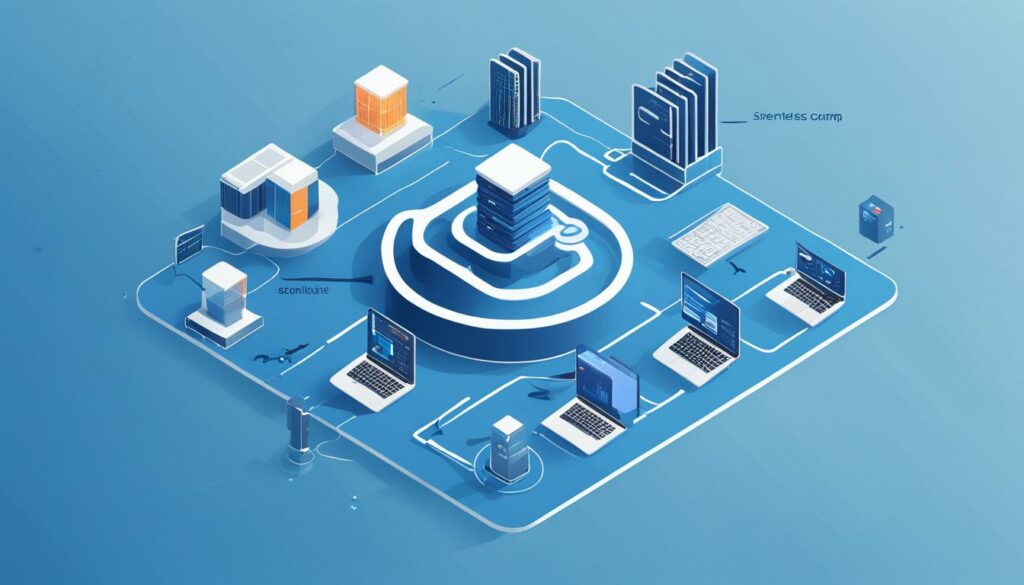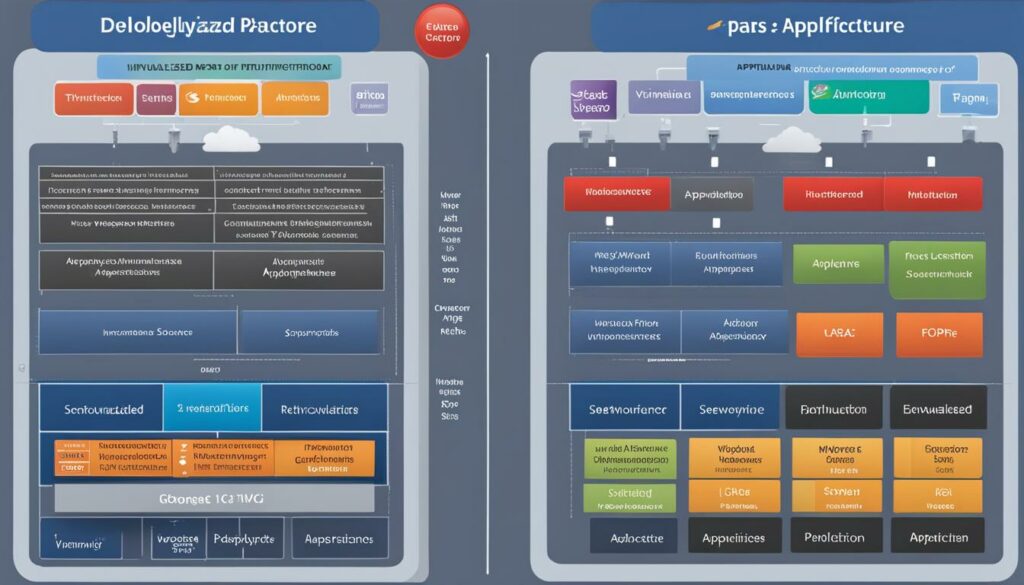Welcome to the future of application deployment! Serverless computing is a revolutionary paradigm shift in the world of IT that allows developers like you to focus solely on writing code, freeing you from the hassles of infrastructure management. With serverless architecture and functions as a service (FaaS), you can say goodbye to the days of provisioning and configuring servers.
Gone are the worries about scalability and resource allocation during peak usage. Serverless computing is event-driven, allowing applications to automatically scale based on demand, ensuring optimal performance for your users. It’s the future of deploying scalable microservices without the need for traditional servers, empowering you to innovate and enhance user experiences.
In the world of cloud computing, serverless is becoming the go-to deployment option for many developers. Cloud 7 IT Services Inc. is here to guide you on this exciting journey. We understand the power and potential of serverless computing, and we are dedicated to helping you leverage its benefits.
To get started on your journey, we recommend WordPress Hosting from BoostedHost. BoostedHost offers optimized hosting solutions that ensure optimal performance for your serverless applications. Sign up now through this link: www.boostedhost.com/wordpress-hosting.
Key Takeaways:
- Serverless computing allows developers to focus solely on writing code, freeing them from infrastructure management.
- Scalability is inherent in serverless architecture, enabling applications to automatically scale based on demand.
- Serverless deployment empowers developers to innovate and enhance user experiences.
- Cloud 7 IT Services Inc. is a trusted technology partner in the serverless computing journey.
- BoostedHost’s WordPress Hosting offers optimized solutions for serverless applications.
Understanding Serverless Computing
Serverless computing is not about the absence of servers but the abstraction of server management. It revolutionizes the way developers approach application development by allowing them to focus solely on writing code without the burden of infrastructure management.
With serverless computing, developers can shift their focus from mundane tasks like server provisioning, scaling, and maintenance to the more creative aspects of software development. This shift in focus improves productivity and efficiency, enabling developers to deliver high-quality applications at a faster pace.
“Serverless computing abstracts away the complexities of server management, allowing developers to purely focus on their code and the value it brings to their applications.”
By removing the need for infrastructure management, serverless computing frees up developers to innovate and experiment with new ideas without worrying about the underlying infrastructure. They can easily build and deploy scalable microservices and event-driven systems, taking full advantage of the cloud computing capabilities.
Serverless computing also offers cost efficiency by eliminating the need for over-provisioning resources. With serverless architectures, applications can automatically scale based on demand, ensuring optimal performance while minimizing unnecessary resource allocation during idle times.
Overall, serverless computing is a game-changer in the world of application development. It empowers developers to focus on what they do best—writing code—while abstracting away the complexities of infrastructure management.
BoostedHost: Your Partner in Serverless Computing
At BoostedHost, we understand the importance of serverless computing in driving innovation and agility for businesses. That’s why we offer top-notch WordPress hosting services that are optimized for serverless architectures and provide the performance and scalability you need for your applications.
Sign up now for BoostedHost’s WordPress Hosting and experience the true power of serverless computing. Visit www.boostedhost.com/wordpress-hosting to get started on your journey towards seamless application development.
Advantages of Serverless Computing
Serverless computing offers several advantages that make it a compelling choice for application deployment. With its inherent scalability, you can ensure optimal performance for your applications during peak usage without wasting resources during idle times. This scalability feature allows your applications to automatically scale based on demand, providing a seamless user experience even when the workload increases.
Additionally, serverless computing eliminates the need for provisioning and maintaining servers. This not only reduces operational costs but also frees up valuable time for developers to focus on more strategic tasks. With serverless architecture, you can rapidly deploy applications, accelerating time-to-market and staying ahead of the competition.
Cost efficiency is another significant benefit of serverless computing. By eliminating the need for upfront server investments and ongoing maintenance, you can lower your overall operational costs. This pay-as-you-go model ensures that you only pay for the resources you use, further optimizing your expenses.
Furthermore, serverless computing empowers developers to drive innovation and enhance user experiences. With the server management abstracted away, developers can fully concentrate on writing code and creating innovative features. This allows for faster iterations, enabling you to deliver new features and updates to your users more frequently.
Overall, the advantages of serverless computing, including scalability, optimal performance, cost efficiency, rapid application deployment, and the ability to drive innovation, make it a compelling choice for modern businesses looking to optimize their IT infrastructure.
BoostedHost: Your Partner for Serverless Computing Success
BoostedHost offers WordPress Hosting services that are perfectly optimized for serverless computing, providing exceptional performance and reliability for your applications. Sign up now through this link: www.boostedhost.com/wordpress-hosting.

| Advantages | Serverless Computing | Traditional Computing |
|---|---|---|
| Scalability | Automatic scaling based on demand | Manual scaling, often inefficient |
| Operational Costs | Eliminates server provisioning and maintenance | Requires upfront investment and ongoing maintenance |
| Deployment Speed | Rapid application deployment | Lengthy setup and configuration process |
| Innovation | Freedom to focus on code and innovation | Infrastructure management distractions |
| User Experience | Enhanced user experiences through faster iterations | Delayed releases and updates |
The Future of Serverless Computing
Serverless computing is not just a trend; it represents a fundamental shift in IT that promises unparalleled efficiency and innovation. As businesses continue to explore the true potential of serverless computing, they are realizing the need to restructure their adoption strategies to deploy it in ways that actually work. The future of serverless computing lies in viewing it as one option among many, selecting applications that can benefit from its architecture, and considering the context in which it should be deployed.
“Serverless computing represents a fundamental shift in IT that promises unparalleled efficiency and innovation.”
In the ever-evolving landscape of technology, serverless computing has emerged as a game-changer, enabling businesses to optimize their resources and maximize efficiency. The traditional approach of managing servers and infrastructure has proven to be time-consuming and resource-intensive. With serverless computing, developers can focus solely on writing code, while the underlying infrastructure is abstracted away.
By eliminating the need for server management, businesses can enjoy increased development productivity and reduced time to market. This empowers developers to dedicate their efforts to innovation, enhancing user experiences, and driving business growth.
Serverless computing also offers inherent scalability, allowing applications to automatically scale based on demand. This scalability ensures optimal performance during peak usage periods, without the need for over-provisioning resources during idle times. Businesses can seamlessly handle fluctuating workloads and cater to increasing user demands without incurring unnecessary costs.
Furthermore, serverless computing provides a cost-efficient model of deployment. Businesses no longer need to invest in provisioning and maintaining servers, which significantly reduces operational costs. With serverless computing, organizations only pay for the actual resource usage, making it a cost-effective solution for startups, small businesses, and enterprises alike.
The future of serverless computing lies in its continuous evolution and adoption across various industries. As businesses recognize the benefits of this innovative technology, they are exploring new ways to leverage its capabilities. From IoT applications to data analysis and machine learning, serverless computing has the potential to revolutionize diverse sectors.
However, it’s important to acknowledge that serverless computing is not a one-size-fits-all solution. It’s crucial for businesses to carefully select the applications that can truly benefit from the serverless architecture and consider the context in which they are deployed. This strategic approach ensures optimal results and avoids potential inefficiencies.
| Benefits of Serverless Computing | Considerations for Successful Adoption |
|---|---|
|
|
The future of serverless computing is bright, presenting endless possibilities for organizations aiming to drive efficiency and foster innovation. With its scalability, cost efficiency, and focus on code development, serverless computing is poised to become an integral part of the IT landscape. As businesses continue to explore its potential, the future will see the development of advanced serverless frameworks, increased integration capabilities, and enhanced monitoring and management tools.
Embrace the future of IT deployment with serverless computing and unlock the full potential of your applications.
Common Mistakes in Serverless Computing
When it comes to serverless computing, one of the common mistakes that businesses make is treating it as a one-size-fits-all solution. But in reality, serverless computing requires careful consideration of various factors to ensure its successful implementation and maximize its benefits. Here are some crucial aspects that often get overlooked:
- Legacy Architecture: Ignoring the existing architecture can lead to integration challenges and hinder the smooth transition to serverless computing. It’s essential to assess your legacy systems and make any necessary updates or modifications to align them with the serverless model.
- Latency Requirements: Serverless computing excels in handling bursty, event-driven workloads. However, if your application requires low latency or real-time processing, it may not be the ideal choice. Consider the latency requirements of your application and evaluate if serverless architecture can meet them effectively.
- Security and Privacy: While serverless computing offers enhanced security measures, it’s crucial to understand the shared responsibility model and take necessary precautions to protect your data. Evaluate the security and privacy features provided by your chosen cloud provider and implement additional measures to safeguard sensitive information.
- Vendor Lock-in: Locking yourself into a specific cloud provider can restrict your flexibility and scalability options in the future. It’s essential to choose a provider that offers portability and interoperability, enabling you to migrate to different platforms easily if required.
Avoiding these pitfalls is essential to ensure the cost-effectiveness and overall success of your serverless computing implementation. By carefully considering legacy architecture, latency requirements, security and privacy concerns, and avoiding vendor lock-in, you can leverage the full potential of serverless computing while avoiding inefficiencies and drawbacks.

Notable Quote:
“Successful implementation of serverless computing requires a holistic approach, considering the specific needs and challenges of your business.” – Jane Johnson, Cloud Computing Expert
Selective Adoption of Serverless Computing
In order to successfully implement serverless computing, it is essential to practice selective adoption. This approach allows your development teams to focus on what they do best – creating custom application functionality – while minimizing the number of infrastructure-related decisions they have to make. By selectively applying serverless architecture to applications where it makes the most sense, you can ensure optimal performance and cost-effectiveness.
Benefits of Selective Adoption
When it comes to serverless computing, the advantages of selective adoption are clear:
- Efficiency: By using serverless computing strategically, you can ensure that your teams are spending their time and resources where they will have the greatest impact – developing unique and innovative functionality that sets your applications apart.
- Scalability: Selective adoption allows you to allocate resources precisely where they are needed, ensuring that your applications can scale seamlessly based on demand.
- Flexibility: By adopting a selective approach, you have the freedom to decide which applications can best benefit from serverless architecture, and can avoid forcing it upon applications where it may not be the best fit.
“Selective adoption of serverless computing empowers your teams to focus on what they do best – creating custom application functionality.”
Optimizing Performance and Cost-Effectiveness
By selectively adopting serverless computing, you can optimize both performance and cost-effectiveness. Rather than attempting to migrate all applications to a serverless architecture, focus on identifying the applications that can truly benefit from it. Consider factors such as the specific requirements of the application, the scalability needed, and the potential cost savings. By carefully choosing which applications to adopt, you can ensure that you are utilizing serverless computing where it will have the greatest impact.

Choosing the Right Cloud Provider for Serverless Computing
When it comes to serverless computing, selecting the right cloud provider is crucial for the success of your implementation. Different providers offer unique strengths and weaknesses that align with specific business needs. The top players in the market, such as AWS, Google Cloud, and Azure, have proven their reliability and scalability in the serverless realm.
So, how do you determine which cloud provider is the best fit for your serverless computing needs? Consider these key factors:
Strengths and Weaknesses:
Each cloud provider has its own strengths and weaknesses in terms of serverless computing capabilities. AWS, for example, boasts a vast array of serverless services and an ecosystem that supports various integration possibilities. Google Cloud offers a serverless environment that seamlessly integrates with its other cloud services, while Azure provides strong enterprise-grade features and integration with Microsoft’s extensive suite of products. Assess your requirements and compare them against the strengths of each provider to make an informed decision.
Companion Products and Integrations:
Another essential aspect to consider is the availability of companion products and seamless integrations. Look for a cloud provider that offers a wide range of well-integrated services, such as databases, message queues, and storage options. This enables you to create a comprehensive, plug-and-play solution without unnecessary complexities or the need for third-party services.
Avoiding Vendor Lock-In:
Vendor lock-in can be a concern when choosing a cloud provider for serverless computing. To avoid potential issues, seek providers that offer standards-based solutions and allow for portability. Be sure to assess the feasibility of migrating your applications to another provider if the need arises, ensuring flexibility and independence.
In conclusion, selecting the right cloud provider for serverless computing is a critical decision that entails analyzing each provider’s strengths, weaknesses, companion products, integration capabilities, and the potential risks of vendor lock-in. By carefully evaluating these factors, you can make an informed choice that aligns with your organization’s specific requirements and sets you up for success in your serverless journey.

| Cloud Provider | Strengths | Weaknesses |
|---|---|---|
| AWS | Extensive serverless service offerings, strong ecosystem, scalability | Complexity for beginners, potentially higher costs |
| Google Cloud | Seamless integration with other Google services, on-demand scalability | Relatively smaller ecosystem, learning curve for new users |
| Azure | Enterprise-grade features, integration with Microsoft products, hybrid cloud capabilities | Steep learning curve, less extensive serverless service offerings |
Cost Considerations in Serverless Computing
When it comes to serverless computing, cost is an important factor to consider. With its transparent costs and pay-as-you-go pricing model, serverless computing offers a cost-effective solution for businesses. By eliminating the need for upfront equipment costs and ongoing maintenance challenges, serverless computing allows you to focus on your core business without worrying about infrastructure management.
However, it’s important to note that organizations with unpredictable workloads may face the challenge of over-provisioning resources. Over-provisioning, the allocation of more resources than necessary, can lead to higher costs. It’s crucial to carefully analyze your resource usage and demand to ensure optimal cost-effectiveness in a serverless environment.
Another cost consideration in serverless computing is performance demands. While serverless architectures are designed to scale dynamically based on demand, it’s essential to ensure that your applications meet the performance demands of your users. Inefficient code or excessive resource usage can impact the overall cost-effectiveness of your serverless solution.
To help you better understand the cost implications of serverless computing, let’s take a closer look at the key factors that can influence your costs:
- Resource Usage: It’s important to monitor and analyze how your applications utilize resources in a serverless environment. Identifying potential bottlenecks or areas of inefficiency can help optimize resource allocation and minimize costs.
- Performance Demands: Ensuring that your applications meet the performance demands of your users is crucial to avoid unnecessary resource allocation. By optimizing your code and monitoring performance metrics, you can strike a balance between performance and cost.
- Over-Provisioning: Organizations with unpredictable workloads may be tempted to over-provision resources to ensure availability during peak usage. While this approach provides scalability, it can result in higher costs. Careful analysis of your workload patterns can help you make informed decisions about resource allocation.
Note: It’s important to conduct regular reviews of your serverless computing costs and adjust your resource allocation based on your evolving needs. This proactive approach can help you maximize the cost-effectiveness of your serverless solution.
Quote:
“Serverless computing offers a transparent and flexible cost model. However, organizations need to carefully monitor their resource usage, optimize performance, and avoid over-provisioning to ensure cost-effectiveness.”
Applications Suitable for Serverless Computing
When considering serverless computing, it’s important to identify which applications are best suited for this innovative approach. Serverless computing thrives in scenarios that require latency management, on-demand operations, and cloud-based scalability. It seamlessly integrates with distributed architectures and event-driven triggers, providing a powerful solution for certain use cases.
However, it’s essential to acknowledge that legacy applications not originally designed for the cloud may require significant updates to function efficiently within a serverless environment. Transitioning these applications can be challenging and may involve code refactoring and rearchitecting to fully leverage serverless capabilities.
Monitoring and debugging are also critical considerations when choosing applications for serverless deployment. Traditional debugging methods may not be applicable, demanding a shift in strategies to effectively identify and resolve issues. Fortunately, various monitoring and debugging tools are available, empowering developers to troubleshoot and optimize serverless applications.
Use Cases Suitable for Serverless Computing
- Microservices architecture: Serverless computing is ideal for building scalable microservices, allowing independent development and deployment of functions as a service (FaaS).
- API endpoints: Leveraging serverless functions for API endpoints provides a flexible and scalable solution, managing traffic spikes efficiently.
- Data processing and analytics: Serverless enables cost-effective data processing and analytics, leveraging cloud providers’ scalable resources.
- Event-driven applications: Serverless computing’s event-driven paradigm is well-suited for applications that react to events in real-time, such as IoT platforms or real-time data processing systems.
- File and data processing: Serverless functions handle file processing tasks, such as resizing images or transforming data formats, with ease and efficiency.
- Web applications: Serverless computing allows developers to focus on building application logic rather than managing infrastructure, speeding up development cycles.
By carefully selecting the appropriate use cases and utilizing serverless computing where it aligns with the unique requirements of an application, businesses can leverage its benefits and embark on a path of efficiency, scalability, and innovation.
| Applications | Suitability for Serverless Computing |
|---|---|
| Microservices architecture | Highly suitable |
| API endpoints | Highly suitable |
| Data processing and analytics | Suitable |
| Event-driven applications | Suitable |
| File and data processing | Suitable |
| Web applications | Suitable |
Conclusion
Serverless computing is revolutionizing the way applications are deployed, offering unprecedented efficiency and innovation. While it may not be suitable for every scenario, selectively adopting serverless computing can help businesses leverage its benefits and enhance the development process. By carefully considering its applicability and aligning it with specific needs and objectives, organizations can achieve optimal results.
In the future, serverless computing is expected to continue shaping the IT landscape, driving efficiency and enabling further innovation. As businesses explore this technology further, it’s crucial to understand that serverless computing is just one option among many. It should be employed where it makes the most sense, taking into account the unique context and requirements of each application.
To ensure optimal performance and efficiency in your serverless deployment, we recommend considering WordPress Hosting from BoostedHost. With BoostedHost, you can unlock the full potential of serverless computing and enjoy seamless integration, reliable support, and unparalleled performance. Sign up now through this link: www.boostedhost.com/wordpress-hosting.
FAQ
Q: What is serverless computing?
A: Serverless computing is a paradigm shift in IT that abstracts the management of servers, allowing developers to focus solely on writing code and eliminating the need for infrastructure management.
Q: What are the advantages of serverless computing?
A: Serverless computing offers inherent scalability, optimal performance, cost efficiency, rapid deployment of applications, and the ability to focus on innovation and enhancing user experiences.
Q: How does serverless computing reshape the future of deployment?
A: Serverless computing represents a fundamental shift in IT that promises unparalleled efficiency and innovation, making it a key component of the future of application deployment.
Q: What are some common mistakes in serverless computing?
A: Businesses often make the mistake of treating serverless computing as a one-size-fits-all solution and overlooking factors such as legacy architecture, latency requirements, security concerns, and vendor lock-in.
Q: How should serverless computing be selectively adopted?
A: Selective adoption of serverless computing allows teams to focus on developing custom application functionality while minimizing infrastructure-related decisions, ensuring optimal performance and cost-effectiveness.
Q: How do you choose the right cloud provider for serverless computing?
A: Choosing the right cloud provider depends on factors such as companion products, support, ease of integration, and the ability to avoid vendor lock-in.
Q: What cost considerations are involved in serverless computing?
A: Serverless computing offers transparent costs and a pay-as-you-go pricing model. However, organizations with unpredictable workloads may require over-provisioning of resources, leading to higher costs.
Q: What applications are suitable for serverless computing?
A: Serverless computing is suitable for applications that can manage latency, operate on-demand, and take advantage of cloud-based scalability. It works well with distributed architectures and event-driven triggers.
Q: How does serverless computing ensure future trends of efficiency and innovation?
A: Serverless computing reshapes the future of application deployment by focusing on efficiency and innovation. Selective adoption and careful consideration of its applicability ensure optimal results.











